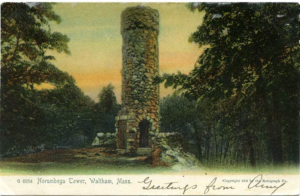
Norumbega,
or Nurembega, is a legendary settlement in northeastern North America which was featured on many early maps from the 1500s until European colonization of the region. It was alleged that the houses had pillars of gold and the inhabitants carried quarts of pearls on their heads.
The word “Norumbega” was originally spelled Oranbega in Giovanni da Verrazzano‘s 1529 map of America, and the word is believed to derive from one of the Algonquian languages spoken in New England. It may mean “quiet place between the rapids” or “quiet stretch of water”. In 1542, Jean Allefonsce reported that he had coasted south from Newfoundland and had discovered a great river. It often appeared on subsequent European maps of North America, lying south of Acadia in what is now New England.
The town of Bangor, Maine, commemorated the legend during the nineteenth century, naming their municipal hall “Norumbega Hall”. In 1886, inventor Joseph Barker Stearns built a mansion named “Norumbega Castle“, which still stands on US Route 1 in Camden, Maine, overlooking Penobscot Bay. During the late 19th century, Eben Norton Horsford associated the name and legend of Norumbega with supposed Norse settlements on the Charles River, and built the Norumbega Tower at the confluence of Stony Brook and the Charles River in Weston, Massachusetts, where he claimed Fort Norumbega was located. In honor of Horsford’s generous donations to Wellesley College, a building named Norumbega Hall was dedicated in 1886 and celebrated in a poem by John Greenleaf Whittier. Presently, the myth is commemorated by such place names as Norumbega Mountain (formerly Brown Mountain) in Acadia National Park.

File:Norumbega-postcard.jpg
Created: circa 1905 date QS:P,+1905-00-00T00:00:00Z/9,P1480,Q5727902
The Norumbega Tower is a stone tower erected by Eben Norton Horsford in 1889 to mark the supposed location of Fort Norumbega, a legendary Norse fort and city. It is located in Weston, Massachusetts at the confluence of Stony Brook and the Charles River. The tower is approximately 38 feet (12 m) tall, composed of mortared field stones with a spiral stone staircase.
Eben Norton Horsford was convinced that the Eastern Algonquian word ‘Norumbega’, which has been taken to mean the general region that is now coastal New England, was derived from ‘Norvega’, meaning Norway. A prominent stone plaque on the tower relates to Norse explorers from the Icelandic sagas. Horsford believed Norumbega to be Vinland. The construction of the tower was accomplished four years before Horsford’s death.
Horsford’s beliefs and tower influenced the naming of Norumbega Park, a well-known recreational complex located across the river in Newton that operated from 1897 to 1964.